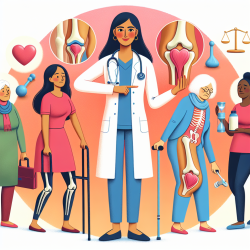Introduction
Osteoarthritis (OA) is a prevalent condition affecting millions worldwide, with women being disproportionately impacted. Despite the availability of management strategies, diverse women often face barriers to accessing equitable, timely, and person-centered OA care. A recent study titled "Multi-level strategies to improve equitable timely person-centred osteoarthritis care for diverse women: qualitative interviews with women and healthcare professionals" provides insights into overcoming these barriers.
Understanding the Barriers
The study highlights several barriers that diverse women face in accessing OA care. These include:
- Delayed care-seeking due to unclear pathways and other commitments.
- Language barriers and lack of interpreters or translated materials.
- Healthcare professionals dismissing OA as a natural part of aging.
- Limited access to female healthcare providers and private consultation spaces.
These barriers underscore the need for a comprehensive approach to healthcare that considers the unique challenges faced by diverse women.
Strategies for Improvement
The research identifies several strategies to improve OA care for diverse women:
Patient-Level Strategies
- Offer education sessions and materials in multiple languages and formats.
- Consider cultural and economic factors when providing treatment advice.
- Establish peer support groups to facilitate self-care.
Healthcare Professional-Level Strategies
- Provide medical and continuing education on OA management tailored to diverse populations.
- Ensure access to interpreters and culturally sensitive care.
System-Level Strategies
- Implement public health campaigns to raise awareness of OA management.
- Establish dedicated inter-professional OA clinics.
- Increase diversity among healthcare professionals.
Implementing Change
Implementing these strategies requires multi-sector collaboration and engagement with diverse women. Healthcare providers can start by incorporating culturally sensitive practices and ensuring that educational materials are accessible to all. Policymakers should focus on creating inclusive policies and funding structures that support these initiatives.
Conclusion
Improving OA care for diverse women is not just about addressing medical needs but also about understanding and overcoming the barriers they face. By implementing the strategies identified in this study, healthcare practitioners can contribute to more equitable and effective OA care.
To read the original research paper, please follow this link: Multi-level strategies to improve equitable timely person-centred osteoarthritis care for diverse women: qualitative interviews with women and healthcare professionals.










